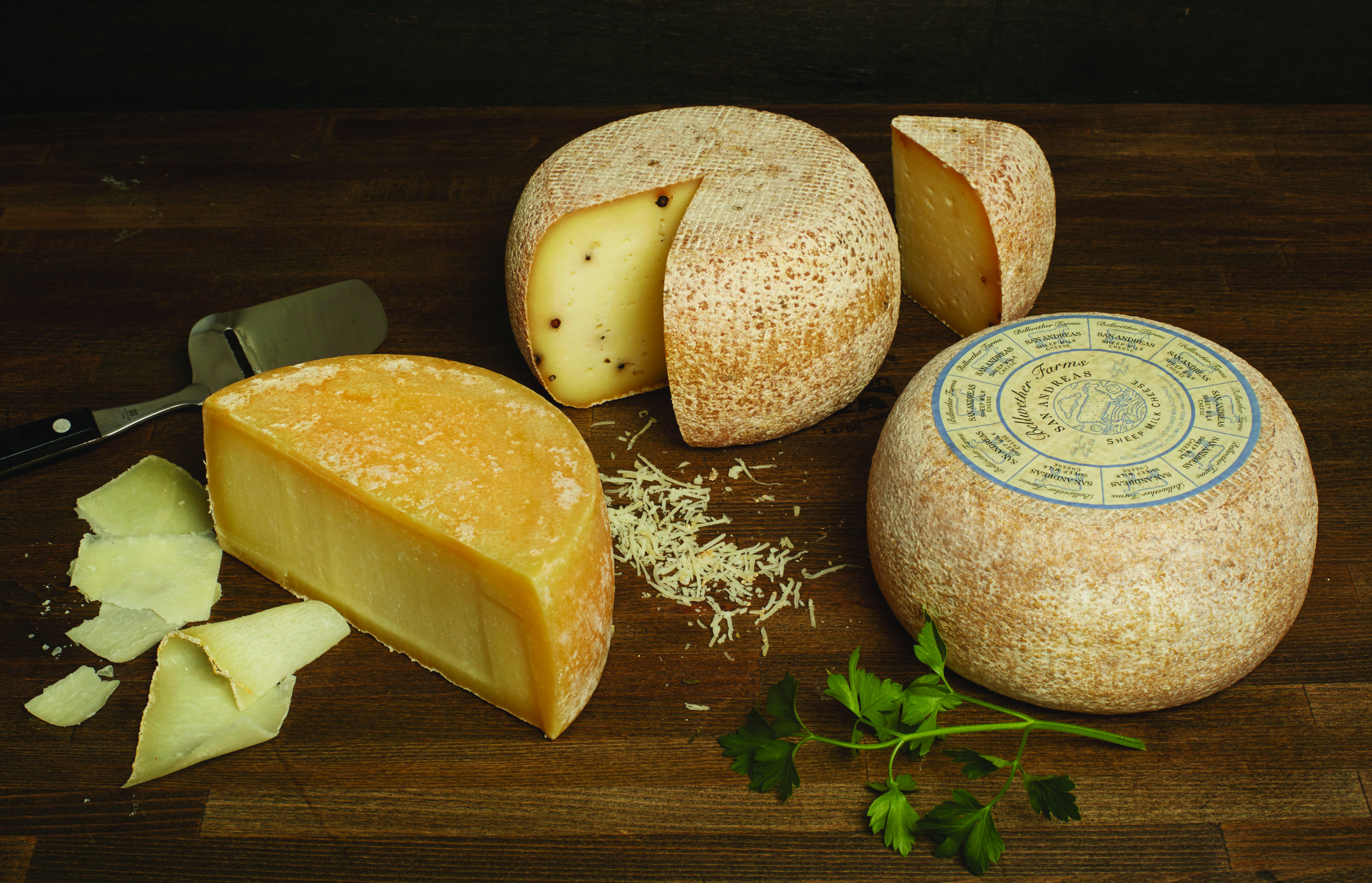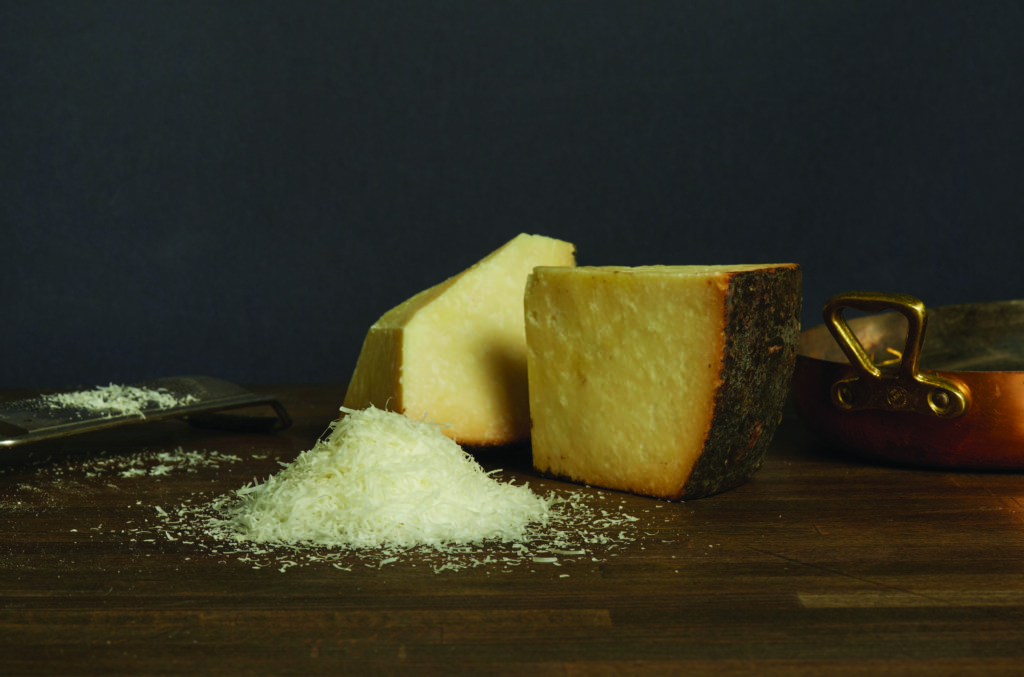
Pecorino, from the Italian word for sheep, is not really a single type of cheese. Rather it describes a family of sheep’s milk cheeses made primarily in the center and south of Italy, from Tuscany and Marche, through Umbria and Lazio, Abruzzo and Molise, Campania and Basilicata, the heel of Puglia and the toe of Calabria, through Sicily and the sheepstrewn island of Sardinia. The land in these torrid regions is mostly arid and poor, too dry and rugged for lumbering, voracious cows, but ideally suited for browsing, sure-footed sheep. It is not entirely free of cows, of course, as evidenced by the great Provolones of Campania and the Ragusanos of Sicily. There are goats too, and water buffalo, whose rich milk is destined for mozzarella. But in this case, the sheep reigns supreme.
Pecorinos are known by many names. Some tell you where the cheese is from, like Pecorino di Pienza, Pecorino Toscano, or Pecorino Siciliano. Some tell how the cheese is aged, such as Pecorino Foglie di Noce, which is swaddled in walnut leaves and aged in terra-cotta amphorae, or the fabled Pecorino di Fossa, which is matured in the caves of Romagna until the Feast of St. Catherine (a novel ripening method and ancient form of tax evasion).
Locally, pecorino is often called simply formaggio, meaning “cheese,” or in Tuscany, cacio, a term that refers to both a cheese and a projectile in the traditional game of Cacio al Fuso in which contestants roll the little cheese around a spindle, hoping theirs flutters to a stop closest to the center. (Like other cheese-based sports, including England’s Cooper’s Hill Cheese Roll, which uses Double Gloucester as its gaming apparatus, Cacio al Fuso has consistently failed to gain a wider audience.)
Pecorinos can be big, like the famous Pecorino Romano, the ancient wax-coated drum of piercingly salty cheese from Lazio and Sardinia that so thoroughly dominates most Americans’ perception of pecorino. Or they may be little, like the oval-shaped Marzolino made early each spring in Siena. Some pecorinos are eaten when just days old; soft and glistening with whey, their flavor is milky and sweet. Some are enjoyed when weeks old, and their texture turns springy and elastic and their flavors grow bolder. Some are savored when months old and hardened to the texture of fudge with the soft graininess of a Bosc pear and a flavor that is warm and burnt-sugar sweet. Some are older still—and hard, salty, and searingly sharp—when eaten.
As a class, pecorinos are relatively simple cheeses to make. No tricky bluing, no finicky white surface molds to grow, no fetid bacterial smears to harness. Many recipes have changed little since Roman times. Although there are some local variations in technique (our apologies to the cheesemaker for the following gross oversimplification of their art), the procedure is similar from region to region.
To make a pecorino, fresh milk is gathered, often by hand, from one of Italy’s traditional breeds of sheep, such as the mop-headed Gentile di Puglia, the brown-faced Comisana, the Roman-nosed Massese, or the long-haired Sarda. The milk—sometimes pasteurized, sometimes not—is warmed and cultured, then separated into curds and whey. Calf, lamb, or kid rennet is typically the coagulating agent of choice for pecorinos (though one, the rare Pecorino di Farindola of Abruzzo, uses pig rennet!), but historically many were made with vegetable-based substances like extract of wild thistle.
Sheep’s milk has a far higher percentage of solids than cow’s or goat’s milk (around 20 percent, compared to cow’s and goat’s at 12 percent). The amount of cheese sheep’s milk yields is therefore high, and the curd it produces is firm, dense, and readily drained. The curd for pecorino is cut into small pieces resembling moist little cubes of custard; the smaller the piece, the dryer the curd and the more age-worthy the cheese. For example, the curds for Pecorino Fresco, a cheese that is eaten when young and supple, are cut to the size of a hazelnut. Curds for middle-aged Pecorino di Pienza Stagionato are cut to the size of a corn kernel. Curds for Pecorino Romano, which ages for eight months or longer, are cut to the size of a grain of rice.
Some pecorino cheesemakers cook the curd; others do not. The curds are ladled into forms, traditionally made from wood of woven rushes or willow, but now mainly perforated plastic. They are drained and turned for a few days, depending on the cheese. Some cheeses are pressed, while others are not. Once the young cheese is sufficiently set, it is removed from its mold and salted, usually by hand with dry salt as opposed to the brine bath favored for many cheeses. Finally, the cheeses are cellared until they reach their desired maturity. Pecorinos speak so clearly of the land, the food, and the traditions of Italy’s sun-drenched provinces. They conjure memories of crumbling palazzi and twisted roads lined with cypress and umbrella pines, of tortured olive trees in ancient orchards, of shepherds and flocks in golden fields. They are ideal companions to the simplest foods and most satisfying wines—like the olive oil that flows green and warm from granite presses, boar sausages hanging in humid cellars, blood-red Chianti and sweet Vin Santo, Cilento figs and fresh favas, spicy mostardas and bitter honeys.
Several of the brightest American cheesemakers have set out to make “pecorino” on US shores, drawing inspiration from the cheeses of Tuscany. In the golden rolling hills of Sonoma—which you would swear are the hills of Chianti if not for the briny scent of the sea air—Liam Callahan of Bellwether Farms makes San Andreas, a four-month-old raw sheep’s milk cheese, and a younger Pepato studded with whole peppercorns. At Dancing Ewe Farm in upstate New York, near Saratoga Springs, Jody Somers and Luisa Scivola-Somers make Fresco and Stagionato Pecorini, in the manner of Luisa’s native Maremma.
The pecorinos of Bellwether and Dancing Ewe look like pecorinos. They smell like pecorinos. They taste like pecorinos. Both have adopted a classic pecorino shape—the plump, flattened ball typical of Pienza. They have the thick, sweet aroma and grassy burnt-sugar flavor of their Tuscan ancestors. But they are subtly different, of course. Their flavors and aromas are cleaner, perhaps because of the modern methods and stringent pasteurization standards in America. They also reflect the grasses of Sonoma, the foothills of the Adirondacks, and the milk of East Friesian ewes as surely as Fiore Sardo speaks of the rock-strewn pastures and sea air of Sardinia, and the milk of the Sarda. Ultimately, if there’s one thing that Old and New World pecorinos have in common it is this—taste of place.
Tasting Notes
Marzolino
Pinzani
Tuscany, Italy
Simple, sweet, and pliably soft. Traditionally made each spring in the Province of Siena.
Calcagno
Casa Madaio
Sardinia, Italy
Rare, sugar-sweet aged pecorino with a golden polished rind.
Fiore Sardo PDO
3 Pecorini
Sardinia, Italy
This is a squat, bulging drum of hard, strong, smoky, and crumbly 100% sheep’s milk cheese.
Pecorino di Pienza Gran Riserva
Luigi Guffanti
Tuscany, Italy
The king of Tuscan pecorino, aged three months or longer. Firm and crystalline; perfectly balanced in sheep and salt.
San Andreas
Bellwether Farms
Petaluma, California
American “pecorino” from the golden hills of the Sonoma coast. Firm, sheepy, and bright.
Pecorino Maremmano
Luigi Guffanti
Tuscany, Italy
Large disk of flaky-yet-succulent, distantly sheepy Tuscan pecorino with a delicate salty backbone.
Cinerino
Casa Madaio
Italy, Campania
Plump, mellow, young pecorino encrusted in the ashes of myrtle branches burnt to honor St. Anthony.
Pecorino di Pienza Fresco
Fratelli Putzulu
Tuscany, Italy
Supple, white, rounded disk. Milky young pecorino, aged twenty days.
Pepato
Bellwether Farms
Petaluma, California
Bright yellow paraffin-dipped wheel of sweet California “pecorino” studded with black peppercorns.




